Sensible Heads
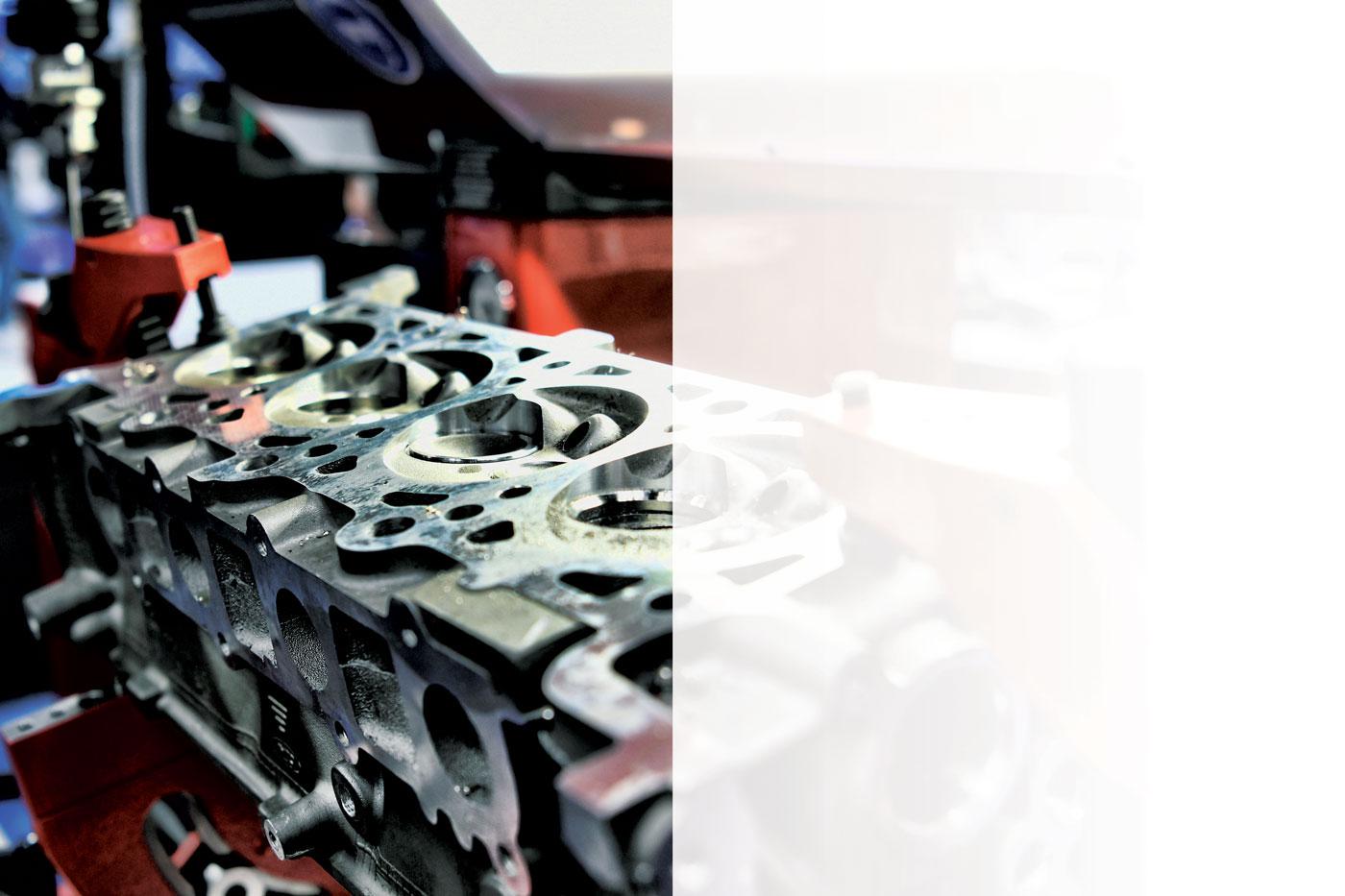
Want to go fast without flattening the wallet? These cylinder heads are designed for power with price point in mind.
There’s no shortage of attention-grabbing slogans that bait and lure budget-minded racers to a great deal on performance parts: “Bang for the buck!” “Cost effective!!” “Price/performance ratio!!!” “Horsepower per dollar!!!!”
Arguably, that grandiose jargon is less prevalent in the cylinder head market. That’s because cylinder heads are a major investment, and winning engine builders aren’t often swayed by cute jingles. A cylinder head is unique in that it’s the single component the rest of the engine is often built around. Breathing is key to horsepower gains, and the cylinder head can’t be the choke point.
Yet, costs shouldn’t be ignored, even in Tier-1 racing classes. The obvious problem is that “budget” is a relative term in racing. A budget head for a claimer motor is certainly not the same budget head for Comp Eliminator or a Trophy Truck.
“Absolutely, it depends on what the budget really is,” said Gavin Simcoe of Frankenstein Engine Dynamics in Weatherford, Texas.
Chris Grace of 1 Way Technologies in Washington, Indiana, has a general strategy when discussing cylinder heads with a team for the first time. The first question is always about the engine brand, simply because 1 Way may not have an applicable product, but it will often recommend the competition to be as helpful as possible.
“They’ll remember that,” noted Grace. “Then we’re going to look at the cost and turnaround time. The lead time on cylinder heads right now is 12–16 weeks. Then we’ll look at the rules and at the product that we have to see if we can provide them with the competitive advantage, legally.”
That discussion then involves all the engine parameters and durability requirements. Cylinder head changes often require adjustments in other areas of the engine. A different combustion chamber may need different pistons. More power may require offset steel rocker arms along with a different induction system. Raised-port heads may require a different intake manifold and exhaust headers.
Fortunately, cylinder head suppliers usually have different lines of products for the most popular engine families so that the engine builder can meet the power requirements while staying within a budget. We sampled a cross-section of the industry to learn about their budget options and strategies for working with cost-conscious customers.
1 Way Technologies
Sanctioning bodies are always shaping rules to help hold down racer costs and may work with manufacturers to establish a spec head, thereby reducing the costs of extensive porting. 1 Way offers a legal cylinder head for the ASCS 360 sprint car series, and the company wants to keep it legal even when customers ask for something extra on the QT.
“Every cylinder head porter will interpret those rules to what they want to read. We as a company are very strict and stringent on our rules reading,” said Grace, noting that having a close dialogue with the tech officials can clear up misunderstandings and make adjustments as needed. “These rules now have allowed us to go in there and improve our product. We were able to work with them, and it’s fair across the board.”
1 Way recently developed a small block Chevy hybrid casting that is versatile enough to be machined for either a R0X head on a 4.500-inch bore spacing or a SB2.2 on a 4.400-inch bore space, thereby lowering the manufacturing costs handed down to the customer. Most of its work, though, comes in developing a variety of CNC-ported race packages using Brodix, All-Pro, Edelbrock, Pro-Filer and OEM castings.
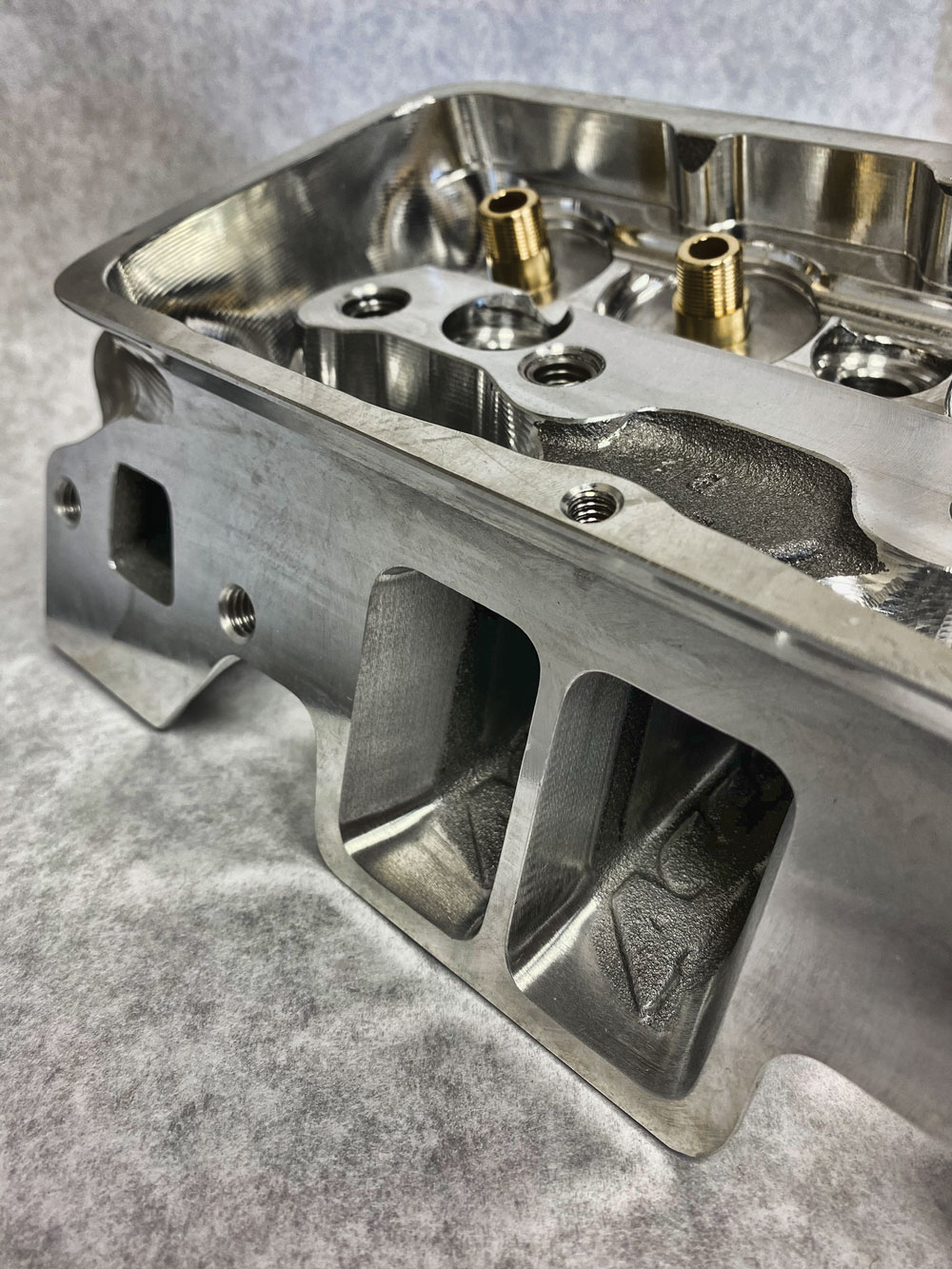
“When we work with those companies, we have them make cylinder heads to our specifications, and then we CNC them to meet the customer needs,” said Grace.
So, in effect, each order is custom, and costs will be reflected in the total package of valves, springs, rocker arms and other equipment in addition to being competitive in a variety of racing disciplines.
“We run the gamut,” added Grace. “From hill climb, time attack, drag, circle track, asphalt and dirt, truck pull, water sports. Anything with an internal combustion engine and an aluminum cylinder head, we’re working on it.”
Air Flow Research (AFR)
CNC machining takes time, which costs money, so if a cylinder head is designed to run with only minimal machining in critical sealing areas after casting, then the cost of the head will be lower. The Enforcer line from AFR in Valencia, California, is driven by this “as-cast” strategy.
“They’re very comparable to some of our entry-level CNC heads but just don’t have that next level of performance,” explained Chris Sperling. “For guys who want that extra five to 10 horsepower, we recommend our CNC heads. However, our as-cast product line has just blown us away both in performance and integrity of the casting.”
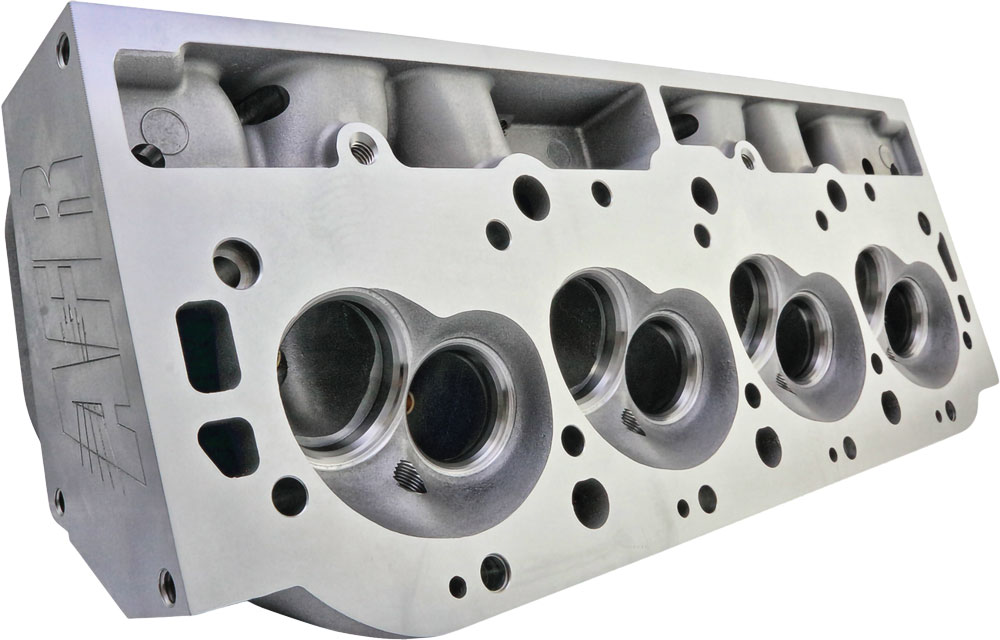
The company’s most popular Enforcer head is the 185cc small block Ford, which has a street price under $600 each, fully assembled. There are also 165cc, 205cc and 220cc versions
“We do a quick little bowl blend on both the intake and the exhaust to make sure that we have smooth transitions from the valve job. That’s one of the more critical areas for flow,” added Sperling, noting that racers are going to get what they pay for. “It’s all in the quality of the components. Using poor quality components may save a little bit. But in the long run, it’s going to cost more with rebuilds or not having the needed tolerances.”
For an engine like the GM LS family, there are plenty of options. The Gen III Hemi, however, is just now starting to gain popularity, so performance options from the aftermarket are limited.
“We’re targeting the Hemi for Q2 release in 2022,” said Sperling. “We have two versions, a CNC-ported job and an as-cast Enforcer. The Enforcer will be a great stock replacement.”
Dyno testing isn’t complete, but Sperling expects the CNC version to flow about 60 cfm better than the as-cast model.
“The potential market for that is across the board because of the product levels that we’re offering,” said Sperling. “This product can go on anything from a naturally aspirated street/strip car all the way up to somebody who’s got a twin-turbo application with 30-plus pounds of boost.”
All-Out Performance
Based in Lindsay, Oklahoma, All-Out Performance is working on a total engine package for racers, and then the shop will release a cylinder head package that leverages that development experience.
At the 2021 PRI Trade Show, the company introduced an EFI LS engine designed for dirt track racing where the rules allow. “A lot of tracks are opening up their engine rules,” said Bryce Koone. “We showed it off in a sprint car chassis, but it could very well be adapted into Late Models or modifieds. Right now, it’s a plenum-style intake manifold, but we’re testing individual runner intakes.”
All-Out Performance is currently using factory GM cylinder head castings to hold down costs. “Again, I can’t say much about our dedicated cylinder head package,” added Koone. “We also want to offer an economy motor package that can bolt onto an existing LS engine for dirt track applications. And we’re testing both cathedral and oval port versions.”
The motor shown at PRI offered about 800 horsepower. “But I left a bunch on the dyno, so we’re hoping to be closer to a thousand,” said Koone, noting that durability is a key goal for the project. “Especially in the economy motor where I want to run them for a season without having to touch it. We’ve got to catch a break in the racing world. Everything is so expensive.”
Brodix
Brodix of Mena, Arkansas, has one of the largest cylinder head catalogs covering different price points and power levels. The company also offers a wide variety of options and upgrades, so a budget head can get pricey with a little extra port work, better valves and upgraded springs.
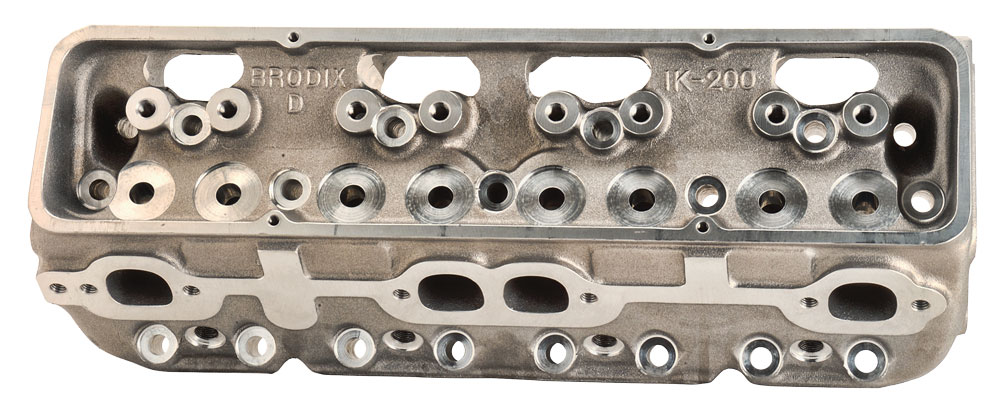
For example, the IK series is Brodix’s budget-priced cylinder head. It comes with either 180cc or 200cc intake ports and either 64cc or 70cc combustion chambers. The same casting can be CNC machined to open up the intake ports to 210cc. This head also receives slightly larger valves and stiffer valve springs.
For the big block Chevy, Brodix has an as-cast version of its popular CNC-ported head called the BB3 Xtra.
“It would be competitive in Super Comp, Super Gas or other index racing,” said Mark Fretz. “We offer it as a copy of our ported head but in an as-cast version. They usually flow within a few CFM of the ported head.”
Brodix is another company that works closely with sanctioning bodies to provide spec heads, which are meant to hold down racing costs by keeping teams from experimenting and testing port and valve-angle designs. One example is its ASCS sprint car head.
“We will give advice about cylinder head technology,” explained Fretz, “but we don’t try to influence rules in any way. Once a rule is in place, then yes, we will develop a head that will utilize all the advantages allowed in the rule. Also, we offer a full line of cylinder heads, and racing organizations may adopt our head as their spec cylinder head. But we do not go out and promote or try to bring in spec-head business.”
Dart Machinery
Dart, which is based in Warren, Michigan, recently gave its budget-minded SHP (short for Special High Performance) series of heads a makeover in celebration of the company’s 40th anniversary. The SHP line includes heads for the small block Chevy and Ford engine families.
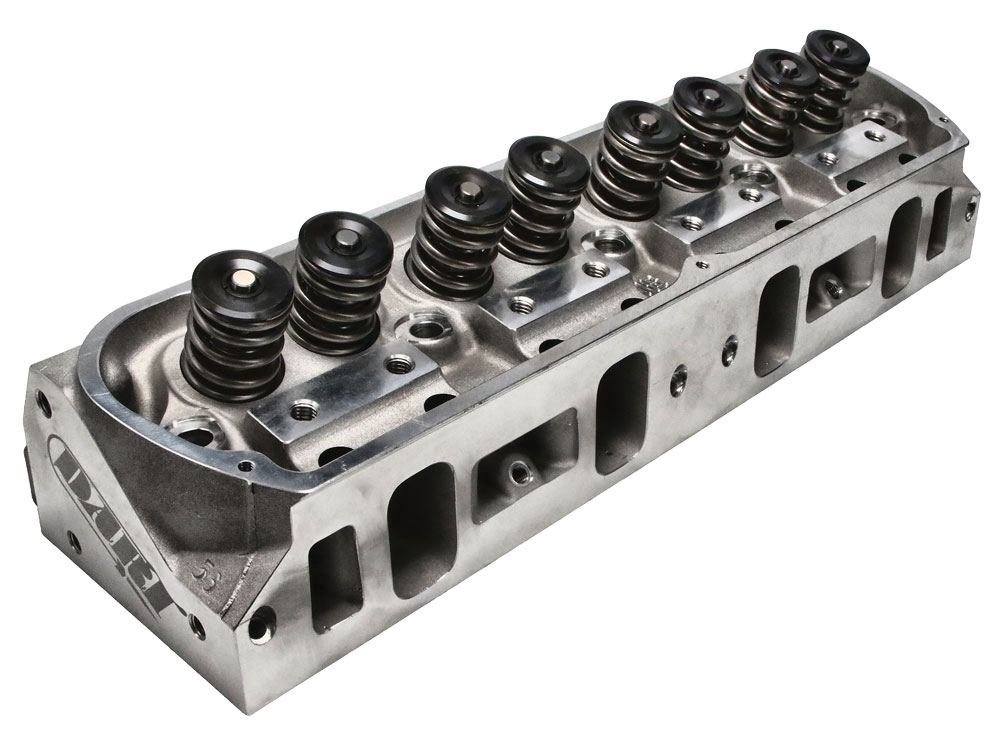
The Ford Windsor-based head features the popular 20-degree valve-angle configuration and touts a revised port design for improved power at an economical cost. The Chevy head is the standard 23-degree configuration, again revising the ports for improved performance.
Both heads can be ordered in bare form or fully assembled, which includes Manley stainless-steel valves and a choice of 7- or 10-degree retainers. There’s also a choice of 1.250-, 1.437- or 1.550-inch-diameter valve springs. Other features include Viton seals, hardened spring cups, guide plates and ARP rocker studs.
The heads are manufactured using a proprietary process with permanent molds and dense aluminum alloy.
Edelbrock
Edelbrock, which recently relocated to Olive Branch, Mississippi, has an easy-to-understand pecking order of its cylinder head lineups. The E-Street group is the least expensive with Ford and Chevy small block, Chevy big block and Chrysler big block kits. Depending on the kit, there are choices of valve size and springs for either a hydraulic roller or flat-tappet camshaft.
The latest offering in E-Street is for the LS cathedral-port engines. They come with either dual or beehive springs, 2.000/1.550 stainless-steel valves and chromoly retainers.
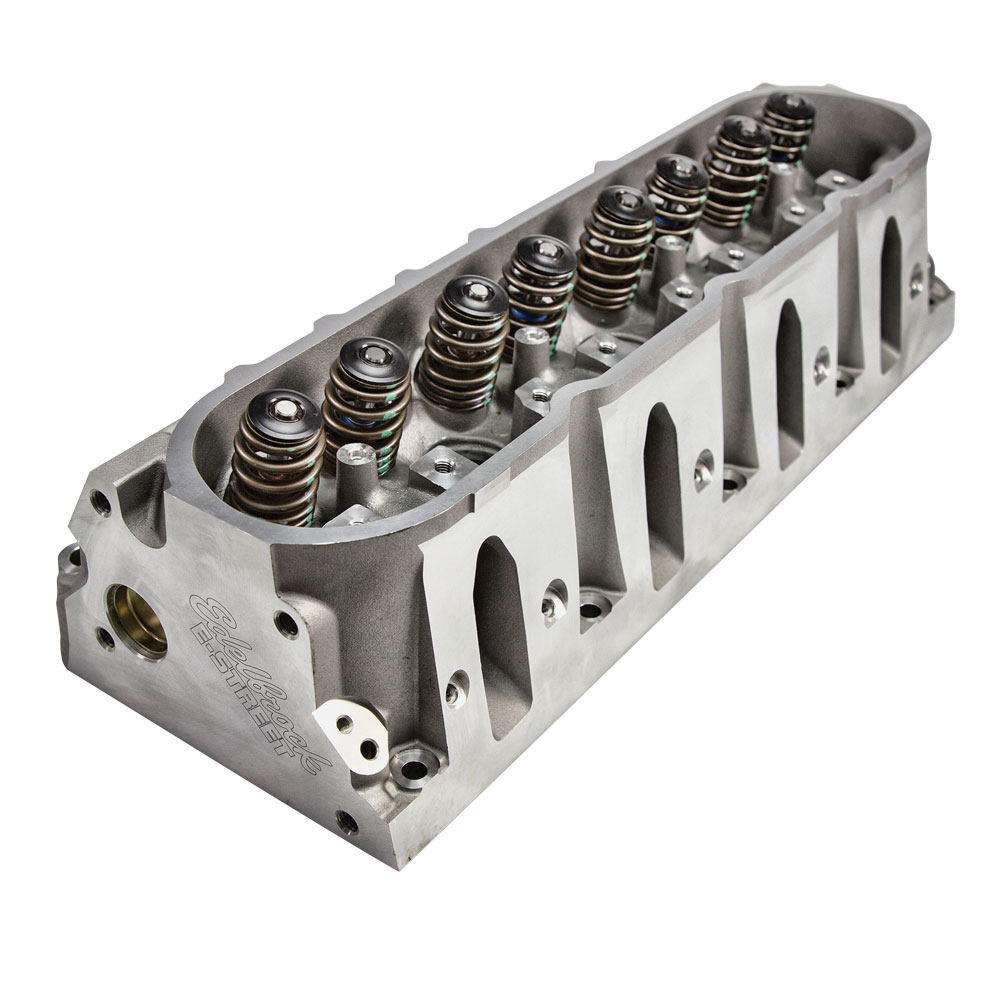
From there, Edelbrock has the Performer, Performer RPM, E-series, E-CNC, Victor Jr and Victor cylinder heads that target different price points and performance levels. As mentioned earlier, the term “budget” is relative to the racing series.
Edelbrock’s new Victor raised-runner, CNC-ported LS7 head may be the budget choice for engine builders seeking very big horsepower. The need for a bigger intake valve drove that head’s development.
“Traditional LS7 has been 12-degree with 2.200-inch intake valve max,” explained Mike Sanders. “We were able to move the guides a little bit to put in a 2.250-inch valve. Now we have more cross-sectional area under the bowl, which moves more air to make more power. It’s no different than raising the port on a big block. There is a better line of sight to the valve. But it should be noted that this head will still work with a stock intake manifold.”
As with many other cylinder head suppliers, Edelbrock is looking at the Gen III Hemi for high-performance potential but won’t disclose any specific details.
“There’s a lot of hype about that market,” added Sanders. “There aren’t really a lot of high-performance cylinder heads available. Edelbrock has a Performer RPM version, but it’s a market that’s starting to develop and will be moving quite quickly.”
Frankenstein Engine Dynamics
The budget-minded Monster cylinder head line at Frankenstein Engine Dynamics is not a basic street upgrade or designed for some forms of restricted racing. These are mid-level cylinder heads for a major leap in power levels over stock, so the base prices start at nearly $1,800 and go up past $2,500 for an assembled set of two.
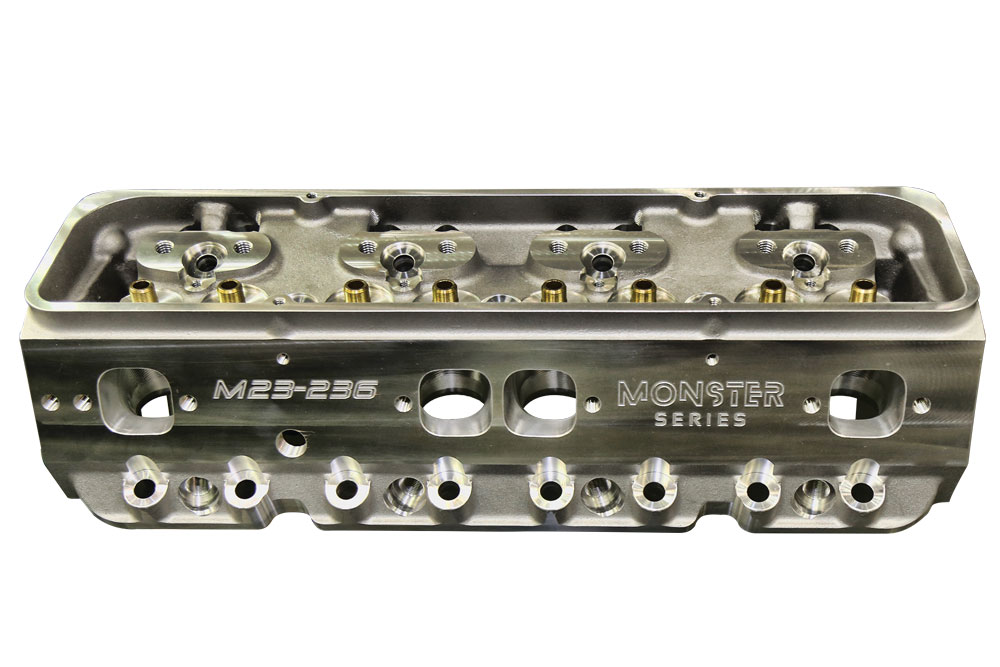
“It really comes down to, how much power can they give for the least amount of money?” said Simcoe. “If we can give them a quality product that lasts, that gives them better than stock at a good price, I think that’s really what we’re aiming for.”
The starting point for the Monster line was the M311 head for LS3-based engines. It features an 11-degree valve angle and 2.165/1.600 valve sizes. It flows almost 400 cfm at .800-inch lift. The head is fully CNC machined, then hand blended and deburred. Options are available.
“We can upgrade to titanium intake valves. We actually have another head that’s the same exact head as this, but we upgraded to a CHE bronze guide and Inconel exhaust valve,” said Simcoe. “We call those the Boost Monsters. What’s nice about this: It’s an entry-level aftermarket cylinder head with a .750 deck, six-bolt head. We don’t recommend pushing these things much over 1,200 horsepower, but we’ve got guys chasing 2,000 and higher and it still hasn’t cracked. They are strong. Racers get all these benefits; plus, the factory intake manifold will fit.”
World Products
There’s still a market for iron heads, driven mostly by restoration shops and racing classes that don’t allow aluminum. While iron heads are heavier, they do offer a much lower price point than aluminum without sacrificing performance, according to Jack McInnis of World Products in Louisville, Kentucky.
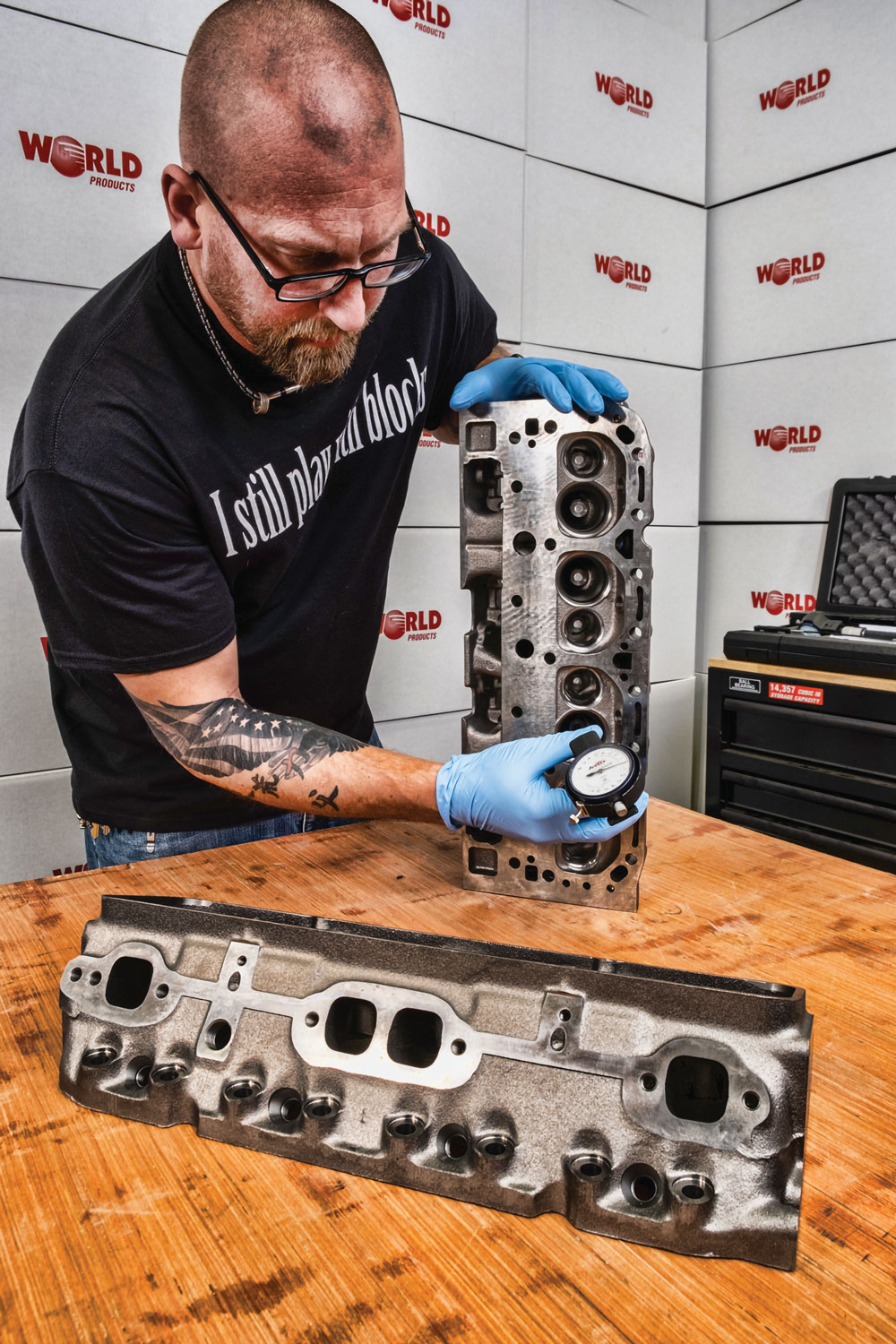
“There’s no difference in power potential between an aluminum and iron head, all things being equal,” said McInnis. “An American-made cast-iron head will offer very good performance for years, for quite a bit less money than an aluminum head. But because an iron head doesn’t dissipate heat as fast, an aluminum head can actually tolerate a bit more compression.
“A lot of the iron-head market is complying with the rules in different types of racing,” he continued. “It can be small block stuff in circle track. For big blocks, it gets into truck pulling. Also, marine applications are growing, especially offshore where salt water wreaks havoc on aluminum.”
Recently, World Products started offering CNC-ported versions of its iron cylinder heads, giving racers and performance enthusiasts an option for more power at a budget price. High Velocity Heads handles the machine work.
“We have a few ported-iron versions for small and big block,” said McInnis. A ported Motown 230 small block head can flow up to 318 cfm at .700-inch lift, while a Merlin 365 that’s been CNC machined will flow nearly 430 cfm at .900-inch lift.
“And again,” McInnis added, “aside from the rules or the corrosion, racers are still saving a good deal of money over ported aluminum heads.”
TWO-WHEEL Performance
Harley-Davidson cylinder heads need love, too, and T-Man Performance in Kernersville, North Carolina, offers different power and price points for all the popular V-twin configurations. For twin-cam, two-valve engines there is a good-better-best choice between the Street Performer, Pro Touring and Thumper series, respectively. The top two heads are designed to work with larger displacements.
“We take existing Harley castings and modify them,” said TR Reiser. “We have a five-axis CNC machine in-house. The Pro Touring is the most popular.”
T-Man even offers a high-output version of the Pro Touring that’s good for 140-plus horsepower on a 124-cubic-inch engine with pump gas.
“On the Thumper, we weld the ports, raise them a little and change the valve angle,” said Reiser, adding that larger valves are also installed. The Thumper program is available only on air-cooled heads because the machine work could invade water jackets on liquid-cooled engines.
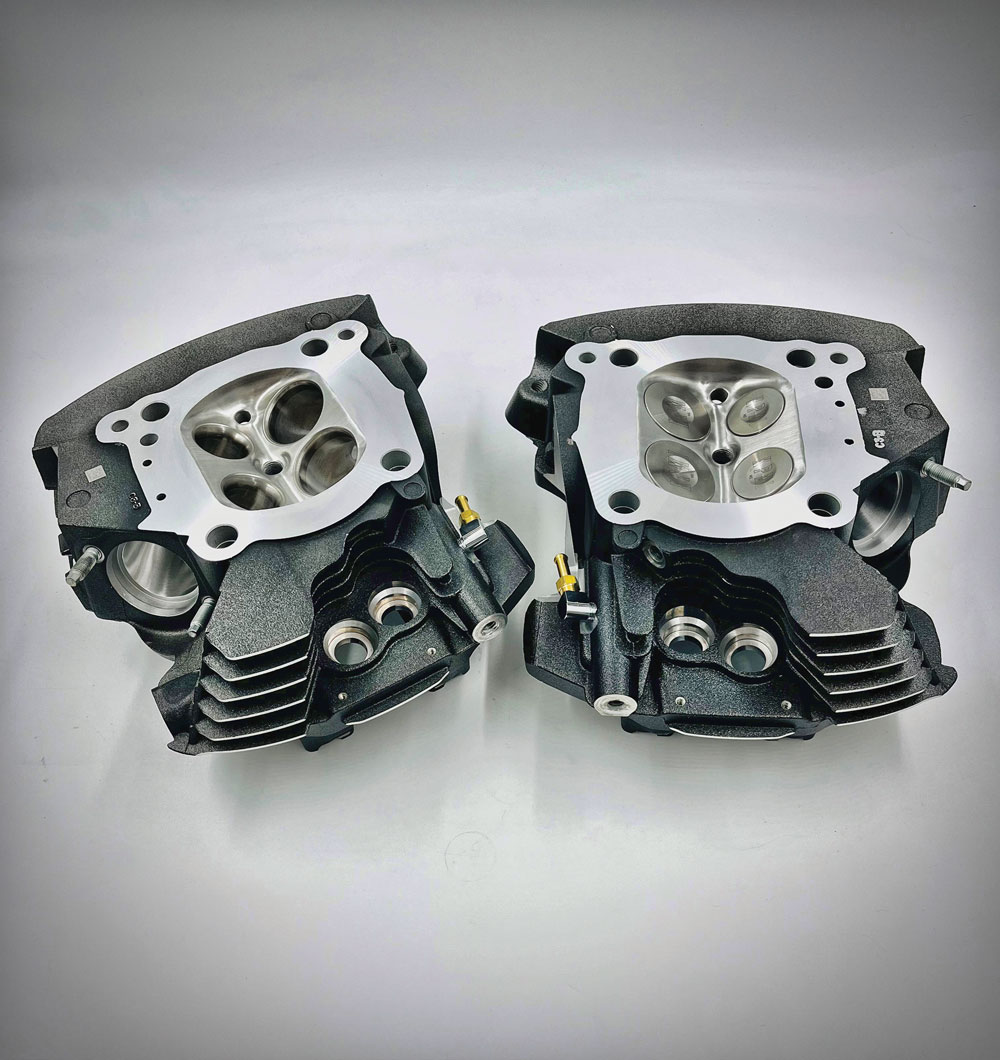
For the four-valve Milwaukee 8 engines, T-Man offers the base Street Fighter, and the Pro Street Touring is the top of the line.
“The Pro Street Touring is the more aggressive head with oversize valves, and it’s fully CNC ported,” said Reiser. “This head is used on 150-plus horsepower engines.” —Mike Magda
Sources
1 Way Technologies
1way-tech.com
Air Flow Research (AFR)
airflowresearch.com
All-Out Performance
facebook.com/aop83/
Brodix
brodix.com
Dart Machinery
dartheads.com
Edelbrock
edelbrock.com
Frankenstein Engine Dynamics
frankensteined.net
T-Man Performance
tmanperformance.com
World Products
pbm-erson.com
 MEMBERSHIP LOGIN
MEMBERSHIP LOGIN JOIN PRI
JOIN PRI


